In the past, people use pigeon to send and receive message for long distance. Later on invention of telegram telegraph and telephone made made a remarkable change in the field of telecommunication. Where, word ‘tele’ means large distance and communication means exchange or sharing ideas, views and information with other individual or machine. Thus, the exchange of data and information between sender and receiver through any given medium following a common rule is known as communication. So, telecommunication is the art of communicating at a distance. Telephone, radio and television are the main and popular media of tele-communication.
After the invention of microcomputers in 1980's, people started using computers and telephone (Internet) lines to send and receive data from one place to another. The use of computers to send and receive data from one location to another is known as data communication.
Basic elements of communication
- Sender (source) which creates the message to be transferred.
- Medium which carry message.
- Receiver (sink) which receives the message
- Data: The information or message to be carried.
- Protocol: Rules to carry the data.
Communication System
As we know, system refers to the integration of several individual units or components interacting with each other to achieve a common objective. Similar, to make an effective communication, we need several communicating unit which interact with each other. This integrated individual functioning components are called communication system.
Modes of communication:
Based on the flow of direction of communication. Communication has 3 modes.
Simplex: It is unidirectional mode of communication on which sender always sends the data and receiver receives it. In this mode receiver never sends the data. For example, radio, television
Half duplex: It is the bidirectional mode of communication in which sender can send the data and receives the data as well and vice versa but only one at a time that means sender is not allowed to receive data while it is sending data. For eg, walkie talkie
Full duplex: It is the bidirectional mode of communication in which both sender and receiver can send and receives data simultaneously. For eg, mobile phones, telephone etc
Computer Network
From the very beginning there is an emerging trend of making communication. People use computer to share different data and information at different location. Thus, the group of computer Interconnected with each other through any type of transportation media that may be either wired on wireless in order to share different hardware software and other resources is known as computer network. The concept of connected computer sharing resources is called Networking. We use different bounded media like twisted pair cable , coaxial cable and fibre optics cable or unbounded media like microwave, radio wave, infrared , satellites to establish connection between different computers at different location
Advantages of computer network
- Hardware sharing: Using computer network expensive hardware devices can be shared among multiple number of computers. For example, in cyber one printer can be shared among multiple number of computers which help to save money as well time.
- Software sharing: Similarly, software also can be shared among computer n a network which helps to access application program from any remote location.
- Centralized control and management: Network provides the centralized control and management that means every other computer in a network are centrally connected with server which controls and monitor all the activities within the network. This helps to ensure security
- Speedy and fast effective communication: Since all the computer in a Network are interconnected with each other, one can sends and receives messages within the computer in just few seconds.
- Backup and Recovery: Since all the computer are connected with server, it helps to maintain backup at periodic interval. that means keeping extra copy so that data and the formation can be recover when lost accidentally or intentionally.
- Flexible Access: In a network a computer can easily access files from other computer he/she has authority or privilege to access/use.
- Work group computing: Network allows different user to work in group that means; different user can work on o single task by dividing work load.
Disadvantage of computer network
- Virus Transfer: Since computer Network allows data and information to be transferred , still there remains the possibility of virus transfer and other malicious program.
- Less reliable: Since computer in a network are inter connected with each other performance of one computer may affect performance of another computer. That means if one computer start malfunctioning in a network than it may affect another computers in a network.
- Security: Computer network is a group of computer interconnected with each other. That means, one computer in a network can access data and information from other computer. Since there may be also possibility of unauthorized access there exist security issue in a network.
- Expensive: Creating a network among different computer is itself a complex task or job. We may need different inter networking devices and others special devices and other to establish a network. Buying all the devices, cables and equipment may be expensive.
- Need Technical Manpower: Since establishing a network is a Technical job we need a technical manpower in order to establish and trouble shoot a network. Hiring technical manpower may be expensive.
Type of Network
On the basis of geographical area covered
- LAN
- MAN
- WAN
On the basis of network architecture
- Peer-to- peer
- Client server
On the basis of geographical area covered
| LAN | MAN | WAN | |
| Area Covered | Room, building | City, village | Across the cities, country |
| Transmission media | Guided/wired | Wired/wireless | Often Wireless |
| Transmission speed | Fastest | Faster | Fast |
| Reliable | Highly | Reliable | Less reliable |
1) LAN: LAN stands for Local Area Network. It is the type of Network which covers small geographical area such as room, building, school, university etc. Since it covers small area, are interconnected with guided or wired media such as twisted pair cable, coaxial cable or fibre optic cable. It is one of the fastest network in term of transmission speed among all other. Since, they are connected with wires they have higher reliability. Some of the implementation of LAN can be in computer lab, cyber, network between different department.
Advantages of LAN
- It is cheaper to establish.
- Data transmission is faster than MAN and WAN.
- It has higher security to resources of the network
- It is eager to establish, manage es of the network and operate
Disadvantages of LAN
- It is limited only to a small area.
- It can connect less number of computers comparatively.
- Cannot be used as distributed network.
2) MAN: MAN stands for Metropolitan Area Network. It covers an entire city, district or village. MAN connects two or more than two LAN together. Big companies like banks, and many organization have their branches or sub offices in a city or in neighboring city use MAN to connect with each other. The communication media in MAN can be guided as well as unguided. This network use bridge, repeater, router, switch etc to establish a connection. The data transmission speed of MAN is faster compared to LAN and slower to thot of LAN. Media like microwave, radio wave, infrared etc are used to connect devices in a MAN.
Advantages of MAN
- It covers larger geographical area than LAN.
- It can connect large number of computer than LAN.
- We can use guided as well as unguided type of transmission media.
Disadvantages of MAN
- It is expensIve to set up then LAN.
- Transmission speed slower compared to LAN.
- It is complex to establish, manage and provides security.
3) WAN: It stands for Wide Area Network, which can be extended to the whole world. It is also known as the network of networks. They are used to connect LANs together so that users and computers in one location can communicate with users and computer in another location. WAN is unlimited. It is the slowest data communication among all of three as it covers entire country, continents or even a whole world. These type of network use unguided media such as microwave, radio wave, satellites and even fibre optics some times to communicate in larger distance. The best example of WAN is Internet which is a public network whereas Intranet is a private network earn by an organizations
Advantage of WAN
- It covers larger geographical area than LAN and MAN.
- It can connect large number of computer compared to LAN and MAN.
- Using WAN communication can be done over a large distance.
Disadvantage of WAN
- It is expensive to establiSh, manage and operate.
- It is the slowest type of network compared to that of LAN and MAN.
- Highly qualified manpower are required to establish and run these type of network.
On the basis of Network architecture.
1) Peer-to-peer: These type of network architecture in which all the computers in a network are connected with each other having equal access and responsibility are known as peer -to-peer network. In this type of network architecture there is no presence of main computer that is server which provides services to the network. All the jobs and task are carried out by themselves without having authority from other computer. Hence, they are known as peers. Each computer in a network behave itself as a client as well as server. This type of architecture can be used to small work group where security may not be of greater issue.
Advantages
- It is simple cheap and easier to set up.
- Since there is no dedicated server, user can manage their own server.
- Failure of a computer in a network doesn't effect the other computer in a network.
Disadvantages
- Data security is very poor in this type of architecture.
- Data recovery and backup is difficult.
- It is not appropriate for large scale organization.
- Network administration is difficult it without dedicated Server.
2) Client server: Unlike peer to peer Network, client server architecture has the main computer called server which control and monitors all the computers or client in a network. The server always provides services to the client. In this type of architecture client cannot carry out any operation without the authority of server. Server act as a central computer in a network. Due to presence of server this type of architecture is much more secure. The data and application program are stored on powerful centrally located server. Each workstation or client on the network shares the resources of the server computer. The server computer is high capacity, high speed and large memory capacity. In this architecture user having client computer can access server only when he/she has right to do so. That means , unauthorized person cannot access the server. On this network the client have to request the server for the the data instead of carrying out by themselves.
Advantages
- Centralized administration is possible through this network.
- High security can be provided by suing appropriate server.
- It is appropriate for large organization.
- Data recovery and backup process is easier.
Disadvantages
- If server fails whole network is affected.
- It is expensive due to use of dedicated server.
- It is complex to establish and manage.
- Experienced administrator is required to operate.
Transmission Media
Wired / guided / bounded
- Twisted pair cable
- Co-axial cable
- Fibre optic cable
Wireless / unguided / unbounded
- Microwave
- Radiowave
- Infrared
- Satellites
Transmission media / communication media
Transmission media are means through which data travel form source to destination. Transmission media are from often called communication media or communication channel. As we know the basic component of communication are sender (source), communication media and receiver (sink / destination) which means communication media are used to transmit data. In other word, the physical channel or pathway through which data travel from one place to another or from one computer to another is called transmission media or communication channel.
Depending upon the cost, requirement and reliability, communication media are classified into:
A) Guided / bounded / wired media
Those type of transmission media in which data are restricted to travel inside a physical wire are known as guided media. In the type of transmission media data have to travel in a closed path. There are different types of guided media
1) Twisted pair cable: As a name suggest in this type of transmission media the pair of cable are twisted around each other. They are twisted in order to reduce the electro magnetic interference (EMI). This type of cable have greater transmission and fewer chance of error in transmission. It is the most common type of transmission media used in telephone system and in most of the LAN. Twisted pair offers some significant benefits. It is cheaper, lighter, thinner, more flexible and easy to install than coaxial cable or fibre optics. Twisted pair cable are found in one pair, two pair and four pair. The media connector used for 4 pair cable is RJ45. Similarly RJ11 are used for two pair twisted pair. There are 2 types of twisted pair cable.
i) UTP (Unshielded Twisted Pair) It is the type of twisted pair cable in which inner pair of conducting wire are not shielded. Since the pair of wire are not shielded they are immune to EMI (Electro Magnetic Interference). It is cheaper and cannot transfer data for longer distance compared to STP. It is the most common twisted pair cable. Eg CAT5
ii) STP (Shielded Twisted Pair) It is the rare type of twisted pair of cable in which inner pair of conducting wire are shielded. In order to reduce EMI. They are expensive and can be used for longer distance of transmission. Eg, lBM type 1
Advantages
- It is cheaper than other cables.
- It is light and thin. So, it is flexible for LAN.
- It can travel data in short distance with higher bandwidth.
Disadvantage
- It is only used for short distance transmission.
- It can be affected by electrical and magnetic field.
- It is slower type of transmission media compared to other cables.
2) Co-axial cable: It is one of the most common television broadcasting transmission media that carries data signal of higher frequency and at higher speed than twisted pair cable. Co-axial cable has large bandwidth and better reliability which means it can handle large volume of data at high speed. The other advantages includes that it can carry signal over significant speed. Co-axial cable has inner layer of conducting wire covered with an insulator which is surrounded by a conducting mesh and finally covered with a jacket. Co-axial cable used BNC connector.
Advantages:
- It is faster and reliable than twisted pair cable.
- It can transfer data over medium range of distance.
Disadvantages
- It is not appropriate for relatively larger distance.
- It is expensive than twisted pair cable.
- It is rarely used in computer network.
3) Fibre Optics: A fibre optics cable is made up of glass or plastic material in order to transmit data in the form of light. This cable are different than other cables as it plays different set of rules that means data are transferred in the form of photons (light) instead of electricity (electron). Since there is no electricity it is completely immune to Electromagnetic Interference (EMI). Hence data are transferred in a very high speed with better reliability & less error. It has enormous bandwidth and can carry signal for long distance. It is also more source than other cable.
Advantages:
- It has higher bandwidth that means it can handle large volume of data.
- This medium can be used for long distance transmission.
- It is the most secured and error free transmission medium.
Disadvantages
- It is one of the expensive type of transmission media.
- It is not used for short distance transmission.
- Highly qualified and technical manpower are required to operate on fibre optics.
[Note: Coaxial cable use BNC (British Naval connector) as a media connector where as fibre optics use ST Connector as its media connector]
B) Unguided media / Unbounded / wireless media
Those types of transmission media in which data doesn't have to travel in a close path. Data are not restricted to travel inside physical wire instead they travel through air medium which are known as unbounded media. For eg; microwave, radiowave, satellite communication, infrared etc
1) Microwave: It is the type of transmission media which are used for longer distance. This type of wave have higher frequency than radio wave hence it can handle large amount of a data. Microwave signal cannot pass obstacles like hills, buildings and others. So, it is necessary that microwave transmission (sender and receiver) must be in line of sight (LOS). The transmitting station must be in visible contact with receiving station.
2) Satellite: They are the microwave transmission system in space. It is used as amplifier or repeater that is used to receive information from one location on the earth, repeats the data and send it to one or more receiving location on the earth. The communication is carried out through uplink and downlink. To make communication possible in even longer distance multiple satellites are used. Satellites are set in geo-stationary orbit directly over the equator which notates in synchronization to the earth hence it looks stationary from any point on the earth.
3) Radio wave: It is the type of wireless transmission medium that con operate on single as well as multiple frequency band. In this type of transmission medium sender and receiver station must not be in the line of sight.
4) Infrared: It is wireless transmission technology that use red-light (below the visibility of human eye) to transmit information. Like fibre optics,information infrared use light for communication. They are commonly used for TV remote. They are used for closed area using line of sight communication. That means it cannot penetrate the wall or any obstacle. It cannot be used in open area or outside the building because sun ray also contain infrared in it which may interfere the communication.
Network Topology / LAN Topology
The physical layout or a geographical orientation of the computer in a network is known as a network topology. There are many different way for setting up LAN. Therefore, topology is a physical arrangement in which computers or devices in a network are interconnected with each other. People may choose different topologies due to different requirement of the user. This requirements may be high speed of data transfer, data security, cost etc.
Types of Network Topology.
1) Bus Topology: In this type of topology every computers or devices in a network are directly connected to a single cable called back-bone or trunk in a linear way. The linear cable is connected with terminator at its end so that, data will not be able to escape. The position of the server is not fixed in this type of topology. The signal pass through the bus in both direction and can be received by all other nodes. All the nodes, In this type of topology has equal access to the bus and there is no discrimination.
Advantages
- It is easy setup.
- It is not expensive as it requires least amount of cable.
- It is easy to implement and extent.
- Terminator doesn't allow data to escape
- Each computer in a network has equal access and priority to communicate on the network.
Disadvantages:
- Since every computer in a network are connected to the bus, if the cable fails to work then whole network is affected.
- As the number of computer increases, performance decreases.
- It cannot cover large geographical area.
2) Ring topology: In this type of topology every computer or devices are connected to a single cable or trunk in a circular way. In this topology, first and last computer are connected with each other. Here, each computer act as a repeater which accepts the incoming signal and regenerate it before pass it to next one. One data may flow either in clockwise or in anti-clockwise direction. If any break through occur the whole network is collapsed. Guided media like twisted pair cable co-axial cable are used for data transmission.
Advantages
- All station (nodes) have equal access.
- As data travels in only one direction, speed is high.
- Since each computer act as a repeater it can be extended to a greater distance.
- Increase in number of computer will have minimal impact to overall network performance.
Disadvantages
- Since every computer are connected with the single cable, if that single cable fails to work whole network is affected.
- Adding computer in this type of network is difficult as we need to rewrite the program.
3) Star Topology: In this type of network every computer and networking devices are connected with centrally located device called hub. It is not always necessary to form a star in this type of topology. Here, client and server both are connected with the hub. So that adding and removing extra computer is fairly easy. Moreover it provides excellent platform for troubleshooting and reconfiguration. In this type of topology breakdown in any medium won’t effect the entire network. The commonly used transmission media in this type of topology is twisted pair cable. It is one of the most popular and practical type of network topology.
Advantages
- Adding and removing computers and devices is very easy.
- If one computer fails to works its doesn’t affect the entire network.
- It is one of the most reliable and practical network topology.
Disadvantage
- It depends upon a central device so if it fails to work it affect the whole network.
- It maybe expensive as we require maximum number of cables and devices.
4) Mesh Topology: As a name suggest computer and devices in a network are randomly connected with each other. It is only true point to point design. This design is one of the most impractical type as it is difficult to install and reconfigure. It require maximum amount of cable. As the number of cable increases, difficulty of the installation increases simultaneously.
Advantages
- Data transmission is faster in this type of topology.
- Since devices are connected point to point , it is one of the reliable network topology.
- Identifying faults and isolating them is easier.
Disadvantages
- It is expensive as it use maximum number of cables.
- This type of network topology is difficult and complex in structure
5) Tree topology (Hybrid topology): This type of topology is the combination of two or more than two type of topology. In this topology both star and bus topology are connected with each other.
[Note: All the advantage and disadvantage of bus and star topology are applicable here.]

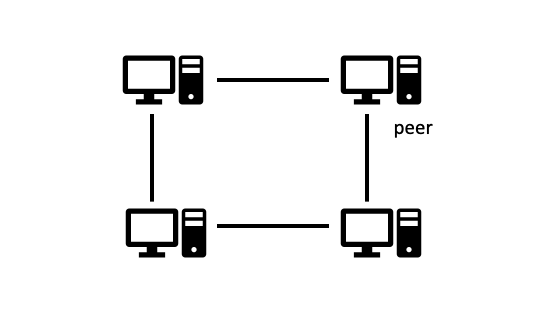
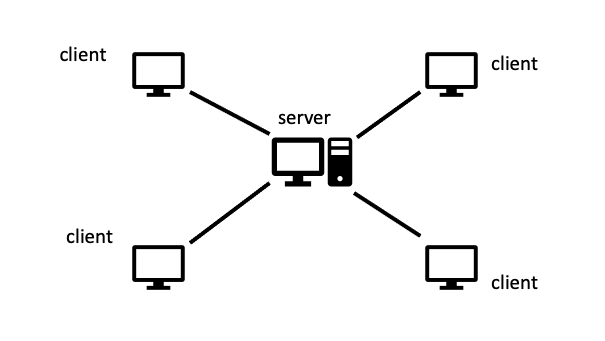
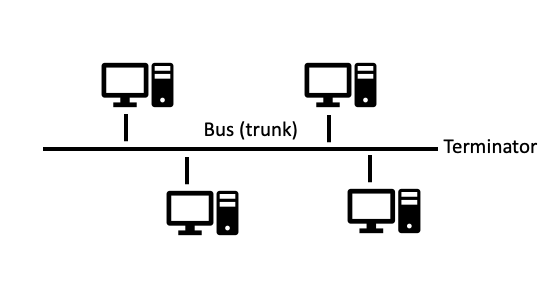
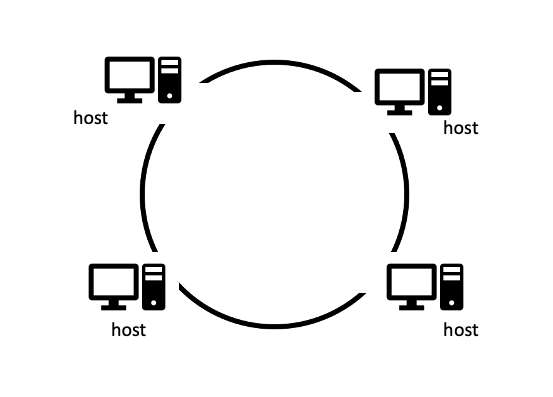
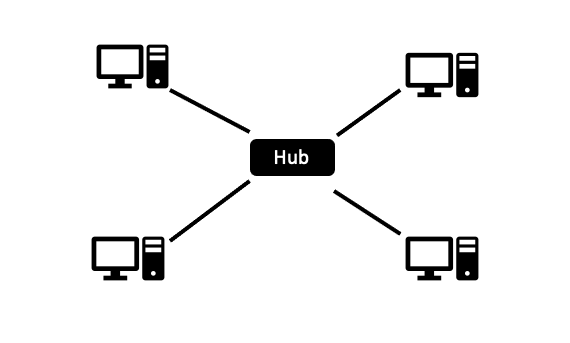
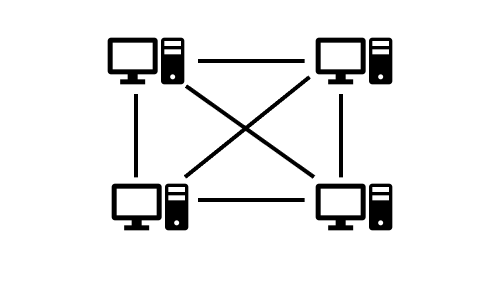
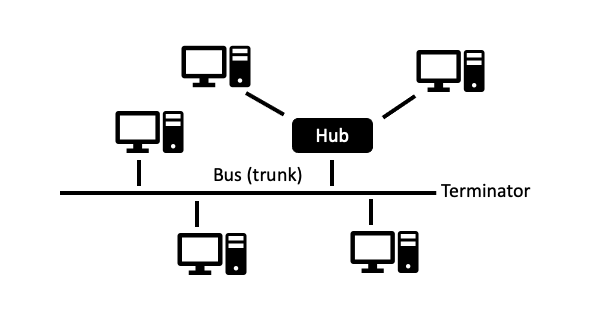

No comments:
Post a Comment